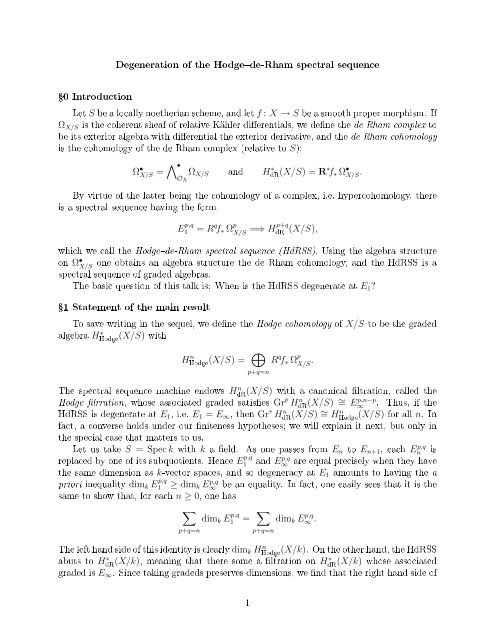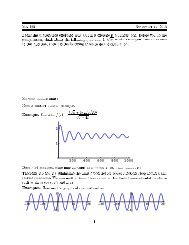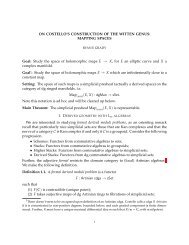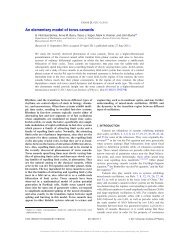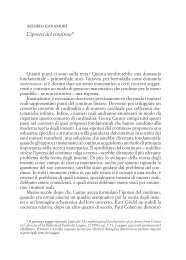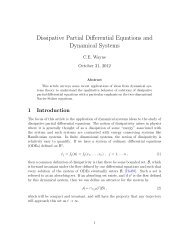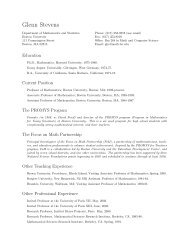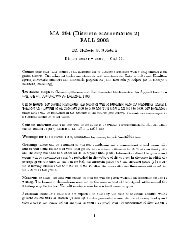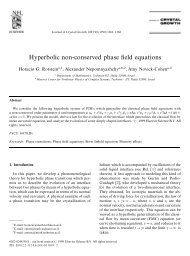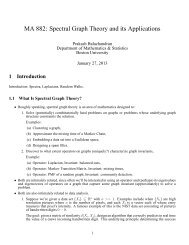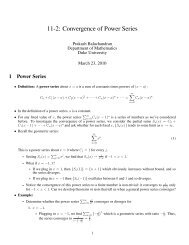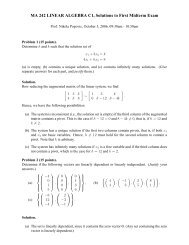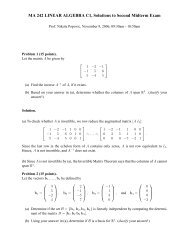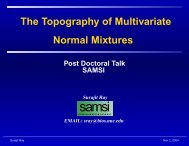Degeneration of the Hodge de-Rham spectral sequence Ÿ0 ...
Degeneration of the Hodge de-Rham spectral sequence Ÿ0 ...
Degeneration of the Hodge de-Rham spectral sequence Ÿ0 ...
You also want an ePaper? Increase the reach of your titles
YUMPU automatically turns print PDFs into web optimized ePapers that Google loves.
<strong>Degeneration</strong> <strong>of</strong> <strong>the</strong> <strong>Hodge</strong><strong>de</strong>-<strong>Rham</strong> <strong>spectral</strong> <strong>sequence</strong><br />
<strong>Ÿ0</strong> Introduction<br />
Let S be a locally noe<strong>the</strong>rian scheme, and let f : X → S be a smooth proper morphism. If<br />
Ω X/S is <strong>the</strong> coherent sheaf <strong>of</strong> relative Kähler dierentials, we <strong>de</strong>ne <strong>the</strong> <strong>de</strong> <strong>Rham</strong> complex to<br />
be its exterior algebra with dierential <strong>the</strong> exterior <strong>de</strong>rivative, and <strong>the</strong> <strong>de</strong> <strong>Rham</strong> cohomology<br />
is <strong>the</strong> cohomology <strong>of</strong> <strong>the</strong> <strong>de</strong> <strong>Rham</strong> complex (relative to S):<br />
Ω • X/S = ∧ •<br />
O X<br />
Ω X/S and H ∗ dR(X/S) = R ∗ f ∗ Ω • X/S.<br />
By virtue <strong>of</strong> <strong>the</strong> latter being <strong>the</strong> cohomology <strong>of</strong> a complex, i.e. hypercohomology, <strong>the</strong>re<br />
is a <strong>spectral</strong> <strong>sequence</strong> having <strong>the</strong> form<br />
E p,q<br />
1 = R q f ∗ Ω p X/S<br />
=⇒ Hp+q (X/S),<br />
dR<br />
which we call <strong>the</strong> <strong>Hodge</strong><strong>de</strong>-<strong>Rham</strong> <strong>spectral</strong> <strong>sequence</strong> (HdRSS). Using <strong>the</strong> algebra structure<br />
on Ω • X/S<br />
one obtains an algebra structure <strong>the</strong> <strong>de</strong> <strong>Rham</strong> cohomology, and <strong>the</strong> HdRSS is a<br />
<strong>spectral</strong> <strong>sequence</strong> <strong>of</strong> gra<strong>de</strong>d algebras.<br />
The basic question <strong>of</strong> this talk is: When is <strong>the</strong> HdRSS <strong>de</strong>generate at E 1 ?<br />
Ÿ1 Statement <strong>of</strong> <strong>the</strong> main result<br />
To save writing in <strong>the</strong> sequel, we <strong>de</strong>ne <strong>the</strong> <strong>Hodge</strong> cohomology <strong>of</strong> X/S to be <strong>the</strong> gra<strong>de</strong>d<br />
algebra H ∗ <strong>Hodge</strong><br />
(X/S) with<br />
H<br />
n <strong>Hodge</strong>(X/S) = ⊕<br />
p+q=n<br />
R q f ∗ Ω p X/S .<br />
The <strong>spectral</strong> <strong>sequence</strong> machine endows H n dR<br />
(X/S) with a canonical ltration, called <strong>the</strong><br />
<strong>Hodge</strong> lrration, whose associated gra<strong>de</strong>d satises Gr p H n (X/S) ∼ dR = E∞<br />
p,n−p . Thus, if <strong>the</strong><br />
HdRSS is <strong>de</strong>generate at E 1 , i.e. E 1 = E ∞ , <strong>the</strong>n Gr ∗ H n (X/S) ∼ dR = H n <strong>Hodge</strong><br />
(X/S) for all n. In<br />
fact, a converse holds un<strong>de</strong>r our niteness hypo<strong>the</strong>ses; we will explain it next, but only in<br />
<strong>the</strong> special case that matters to us.<br />
Let us take S = Spec k with k a eld. As one passes from E n to E n+1 , each En<br />
p,q is<br />
replaced by one <strong>of</strong> its subquotients. Hence E p,q<br />
1 and E∞<br />
p,q are equal precisely when <strong>the</strong>y have<br />
<strong>the</strong> same dimension as k-vector spaces, and so <strong>de</strong>generacy at E 1 amounts to having <strong>the</strong> a<br />
priori inequality dim k E p,q<br />
1 ≥ dim k E∞<br />
p,q be an equality. In fact, one easily sees that it is <strong>the</strong><br />
same to show that, for each n ≥ 0, one has<br />
∑<br />
p+q=n<br />
dim k E p,q<br />
1 = ∑<br />
p+q=n<br />
dim k E p,q<br />
∞ .<br />
The left hand si<strong>de</strong> <strong>of</strong> this i<strong>de</strong>ntity is clearly dim k H n <strong>Hodge</strong><br />
(X/k). On <strong>the</strong> o<strong>the</strong>r hand, <strong>the</strong> HdRSS<br />
abuts to H ∗ (X/k), meaning that <strong>the</strong>re some a ltration on dR H∗ dR<br />
(X/k) whose associated<br />
gra<strong>de</strong>d is E ∞ . Since taking gra<strong>de</strong>ds preserves dimensions, we nd that <strong>the</strong> right hand si<strong>de</strong> <strong>of</strong><br />
1
<strong>the</strong> above i<strong>de</strong>ntity is dim k H ∗ dR<br />
(X/k). To summarize, <strong>the</strong> <strong>de</strong>generacy <strong>of</strong> HdRSS for a scheme<br />
X over a eld k amounts to <strong>the</strong> simple claim that<br />
dim k H n <strong>Hodge</strong>(X/k) = dim k H n dR(X/k)<br />
for all n. The converse allu<strong>de</strong>d to above now follows: if <strong>the</strong>re exists any ltration on<br />
H n (X/k) whose associated gra<strong>de</strong>d is isomorphic to dR Hn <strong>Hodge</strong><br />
(X/k), <strong>the</strong>n <strong>the</strong> above i<strong>de</strong>ntity<br />
<strong>of</strong> dimensions holds.<br />
The following is <strong>the</strong> main result <strong>of</strong> this talk.<br />
Theorem 1. Let k be a eld <strong>of</strong> characterstic 0, and X/k a smooth proper variety. Then<br />
HdRSS <strong>de</strong>generates, i.e. dim k H ∗ <strong>Hodge</strong> (X/k) = dim k H ∗ dR (X/k).<br />
There are three known pro<strong>of</strong>s. For <strong>the</strong> rst, one makes use <strong>of</strong> <strong>the</strong> <strong>Hodge</strong> <strong>de</strong>composition<br />
<strong>of</strong> projective varieties over <strong>the</strong> complex numbers C. For <strong>the</strong> second, one makes use <strong>of</strong> <strong>the</strong><br />
<strong>Hodge</strong>Tate <strong>de</strong>composition <strong>of</strong> projective varieties over p-adic local elds K, upon <strong>the</strong>ir base<br />
change to a completed algebraic closure C K . (When K = Q p , <strong>the</strong> latter is <strong>of</strong>ten written C p .)<br />
In both pro<strong>of</strong>s, one extends to <strong>the</strong> smooth proper case by Chow's lemma and Hironaka's<br />
resolution <strong>of</strong> singularities. Then, one <strong>de</strong>duces <strong>the</strong> result for arbitrary k using <strong>the</strong> Lefschetz<br />
principle. The third pro<strong>of</strong>, due to DeligneIllusie, gives a criterion for <strong>the</strong> <strong>de</strong>generation <strong>of</strong><br />
<strong>the</strong> HdRSS in characteristic p, and <strong>the</strong>n uses a variant <strong>of</strong> <strong>the</strong> Lefschetz principle to reduce<br />
to this case.<br />
We give in this talk an exposition <strong>of</strong> DeligneIllusie's pro<strong>of</strong>, following <strong>the</strong>ir paper very<br />
closely. The structure <strong>of</strong> <strong>the</strong> pro<strong>of</strong> consists <strong>of</strong> several reduction steps. Each reduction leads<br />
us to an interesting new thing to see or prove.<br />
Ÿ2 Reduction to characteristic p>0<br />
We assume from <strong>the</strong> outset that X is connected, because if <strong>the</strong> <strong>the</strong>orem holds for <strong>the</strong><br />
connected components <strong>of</strong> X, <strong>the</strong>n it clearly holds for X. In particular, X has constant<br />
dimension d.<br />
A standard variant <strong>of</strong> <strong>the</strong> Lefschetz principle guarantees <strong>the</strong> existence <strong>of</strong> <strong>the</strong> following<br />
very noncanonical data: a nitely generated Z-algebra A, a ring homomorphism A → k,<br />
a smooth proper A-scheme X, and an isomorphism X k<br />
∼ = X. After possibly localizing A,<br />
we can assume that <strong>the</strong> coherent A-modules H n (X/A) and dR Hn <strong>Hodge</strong><br />
(X/A) are locally free.<br />
Fur<strong>the</strong>rmore, invert in A all rational primes p with p ≤ d.<br />
Because our cohomology groups are locally free, at base change implies that <strong>the</strong>ir formation<br />
commutes with base arbitrary change: for any g : T → Spec A, one has g ∗ H⋆ n (X/A) ∼ =<br />
H⋆ n (X T /T ), with ⋆ = dR or <strong>Hodge</strong>. In particular, for any any ring map A → l to a eld l<br />
one has<br />
dim l H⋆ n (X l /l) = rank A H⋆ n (X/A) = dim k H⋆ n (X/k),<br />
and <strong>the</strong> question <strong>of</strong> <strong>de</strong>generacy <strong>of</strong> <strong>the</strong> HdRSS is equivalent for all <strong>the</strong> X l /l. Let us now<br />
choose a particular member <strong>of</strong> this last family.<br />
Pick a closed point t ∈ Spec(A ⊗ Q), and let T = {t} ⊆ Spec A be its scheme-<strong>the</strong>oretic<br />
closure. Then T → Spec Z is quasi-nite at. Choose a closed point s ∈ T at which<br />
T → Spec Z is étale. By our setup, <strong>the</strong> local ring O T,s has maximal i<strong>de</strong>al is generated by a<br />
2
ational prime p, and its residue eld l is nite. Noting that l is perfect, this implies that<br />
O T,s /(p 2 ) ∼ = W 2 (l), <strong>the</strong> ring <strong>of</strong> p-typical Witt vectors <strong>of</strong> length 2 over l.<br />
Supposing S ↩→ ˜S is a closed immersion <strong>de</strong>ned by a square-zero i<strong>de</strong>al, and X → S is a<br />
at morphism, by a lift <strong>of</strong> X to ˜S we mean a at map ˜X → ˜S equipped with an isomorphism<br />
˜X × eS S ∼ = X. If X/S is smooth <strong>the</strong>n ˜X/ ˜S automatically is too. Thus, in <strong>the</strong> preceding<br />
setup, X OT,s /(p 2 ) is clearly a smooth lift <strong>of</strong> X l to W 2 (l), and <strong>the</strong> <strong>de</strong>generacy <strong>of</strong> HdRSS for our<br />
original X/k will follow from <strong>the</strong> following <strong>the</strong>orem.<br />
Theorem 2. Let k be a perfect eld <strong>of</strong> characteristic p > 0, and let X/k be any smooth<br />
proper scheme <strong>of</strong> dimension d < p. If X admits a smooth lift to W 2 (k), <strong>the</strong>n <strong>the</strong> HdRSS <strong>of</strong><br />
X/k is <strong>de</strong>generate at E 1 .<br />
The <strong>de</strong>generacy <strong>of</strong> HdRSS fails quite <strong>of</strong>ten in characteristic p, when <strong>the</strong> requirement that<br />
d < p is relaxed; see DeligneIllusie for some references. (Somehow, wi<strong>de</strong>spread <strong>de</strong>generacy<br />
<strong>of</strong> <strong>the</strong> HdRSS is a hallmark <strong>of</strong> <strong>the</strong> characteristic 0 world. In fact, in crystalline <strong>de</strong>formation<br />
<strong>the</strong>ory, one obtains a <strong>de</strong>formation from char p to char 0 in exchange for supplying a <strong>Hodge</strong><br />
ltration on <strong>the</strong> putative <strong>de</strong> <strong>Rham</strong> cohomology, i.e. evi<strong>de</strong>nce <strong>of</strong> a HdRSS <strong>de</strong>generation!)<br />
In spite <strong>of</strong> this, DeligneIllusie work henceforth entirely in characteristic p geometryeven<br />
working over a more general base F p -scheme S, although we stick to S = Spec k to keep our<br />
statements simple.<br />
Ÿ3 Reduction to <strong>de</strong>composition <strong>of</strong> <strong>the</strong> <strong>de</strong> <strong>Rham</strong> complex<br />
We begin this section with some preliminaries.<br />
Recall that, for S any F p -scheme, <strong>the</strong>re is a morphism <strong>of</strong> schemes F S : S → S called <strong>the</strong><br />
absolute Frobenius morphism, acting as <strong>the</strong> i<strong>de</strong>ntity on |S| and as <strong>the</strong> pth power map on O S .<br />
If f : X → S is any map, <strong>the</strong>n we set X ′ = X × S S with S → S via F S , and call X ′ <strong>the</strong><br />
Frobenius twist <strong>of</strong> X (relative to S). In down-to-earth terms, X ′ is obtained by taking <strong>the</strong><br />
<strong>de</strong>ning equations <strong>of</strong> X and raising <strong>the</strong>ir coecients to <strong>the</strong> pth power.<br />
Moreover, one has F S ◦ f = f ◦ F X , and this commutativity leads to a map F X/S , called<br />
<strong>the</strong> relative Frobenius morphism <strong>of</strong> X (consi<strong>de</strong>red as an S-scheme), characterized as <strong>the</strong><br />
unique dotted arrow making <strong>the</strong> following diagram commutative.<br />
X F X<br />
<br />
X ′ GX/S X<br />
f<br />
f ′ f<br />
<br />
S F S<br />
S<br />
We will <strong>de</strong>note F X/S more briey by F when no confusion my arise. In down-to-earth terms,<br />
given a solution to <strong>the</strong> equations <strong>de</strong>ning X, <strong>the</strong> map F raises its coordinates to <strong>the</strong> pth<br />
power, after which <strong>the</strong>y satisfy <strong>the</strong> equations <strong>de</strong>ning X ′ . The map F is an S-map and is<br />
nite at <strong>of</strong> <strong>de</strong>gree p, so that F ∗ is exact and fully faithful, and H ∗ (X ′ , F ∗ M) ∼ = H ∗ (X, M)<br />
for any quasicoherent O X -module M.<br />
Finally, we recall here an important construction due to Cartier. For a complex M • <strong>of</strong><br />
sheaves, use H ∗ M • to <strong>de</strong>note <strong>the</strong> cohomology sheaves <strong>of</strong> M • with respect to <strong>the</strong> dierentials<br />
(as opposed to sheaf cohomology).<br />
3
Theorem 3. Let S be any F p -scheme and let X/S be smooth. Then <strong>the</strong>re exists a unique<br />
homomorphism <strong>of</strong> gra<strong>de</strong>d O X ′-algebras<br />
C −1 : ⊕ i≥0<br />
Ω i X ′ /S −→ ⊕ i≥0<br />
H i (F ∗ O X/S )<br />
with <strong>the</strong> property that, for every local section s <strong>of</strong> O X with image G ∗ X/S s = x ⊗ 1 in O X <strong>the</strong> ′<br />
map C −1 sends d(x ⊗ 1) to <strong>the</strong> class <strong>of</strong> x p−1 dx. Moreover, C −1 is an isomorphism <strong>of</strong> gra<strong>de</strong>d<br />
O X ′-algebras.<br />
The map C −1 above is called <strong>the</strong> (inverse <strong>of</strong> <strong>the</strong>) Cartier isomorphism.<br />
Let us specialize to S = Spec k and X/k smooth proper <strong>of</strong> dimension d < p, as in<br />
Theorem 2. Again, we can assume X is connected. Our present step is to implement <strong>the</strong><br />
following wishful thinking. The two si<strong>de</strong>s related by <strong>the</strong> Cartier isomorphism are naturally<br />
<strong>the</strong> H i <strong>of</strong> complexes on X ′ , respectively<br />
⊕<br />
i<br />
Ω i X ′ /k[−i] and F ∗ Ω • X/k,<br />
<strong>the</strong> rst <strong>of</strong> <strong>the</strong>se being <strong>the</strong> complex with Ω i X ′ /k<br />
in each <strong>de</strong>gree i and with dierentials d = 0.<br />
Experience with <strong>de</strong>rived categories tells us that natural operations on cohomology tend to<br />
come from operations on <strong>the</strong> un<strong>de</strong>rlying complexes. So we may wish that C −1 be <strong>the</strong> H ∗<br />
<strong>of</strong> a map C0 −1 between <strong>the</strong>se complexes in D(X ′ ) := D b (qCoh(X ′ )), <strong>the</strong> boun<strong>de</strong>d <strong>de</strong>rived<br />
category <strong>of</strong> quasicoherent O X ′-modules. (In particular, C −1 being an isomorphism, C0<br />
−1<br />
would be a quasi-isomorphism, i.e. an isomorphism in D(X ′ ).)<br />
Such maps C0 −1 do not always exist, essentially because <strong>the</strong> HdRSS does not always<br />
<strong>de</strong>generate when d > p, and, we shall now see, <strong>the</strong> HdRSS <strong>de</strong>generates when a C0 −1 exists.<br />
Suppose given a C0 −1 , and that X/k is proper. Then<br />
HdR(X/k) n = H n (X, Ω • X/k) = H n (X ′ , F ∗ Ω • X/k) C−1 0 ⊕<br />
∼ = H n−i (X ′ , Ω i X/k) = H<strong>Hodge</strong>(X n ′ /k),<br />
whence dim k H n (X/k) = dim dR k H n <strong>Hodge</strong> (X′ /k) for all n. On <strong>the</strong> o<strong>the</strong>r hand, <strong>the</strong> pth power<br />
map k → ∼ k is an extension <strong>of</strong> elds, hence at, and one has H n <strong>Hodge</strong> (X′ /k) = H n (X/k)⊗ <strong>Hodge</strong> kk.<br />
This gives dim k H n <strong>Hodge</strong> (X′ /k) = dim k H n <strong>Hodge</strong><br />
(X/k) for all n, and <strong>the</strong> <strong>de</strong>sired i<strong>de</strong>ntity <strong>of</strong><br />
dimensions follows.<br />
We now see that we are reduced to proving <strong>the</strong> following <strong>the</strong>orem.<br />
Theorem 4. Let k be a prefect eld <strong>of</strong> characteristic p, and X/k a smooth (not necessarily<br />
proper) variety. One can associate to each lift ˜X <strong>of</strong> X to W2 (k) a canonical morphism<br />
i<br />
ϕ = ϕ eX : ⊕ i
As mentioned previously, <strong>the</strong> property that H ∗ ϕ = C −1 implies that ϕ is an isomorphism<br />
in D(X ′ ). We say that ϕ realizes a <strong>de</strong>composition <strong>of</strong> <strong>the</strong> (image <strong>of</strong> <strong>the</strong>) <strong>de</strong> <strong>Rham</strong> complex<br />
(un<strong>de</strong>r F ∗ ) by equating it in D(X ′ ) to a complex with dierential d = 0. DeligneIllusie<br />
actually prove a more general <strong>the</strong>orem, in two ways. First, <strong>the</strong>y give conditions that generalize<br />
<strong>the</strong> base k to an F p -scheme S. Second, <strong>the</strong>y give a result that is valid for schemes<br />
<strong>of</strong> dimension d > p, by producing a morphism ϕ relating only <strong>the</strong> truncations <strong>of</strong> <strong>the</strong> two<br />
complexes to <strong>the</strong>ir components <strong>of</strong> <strong>de</strong>gree < p. This implies that E i,j<br />
1 = E ∞ i, j for i + j < p<br />
in <strong>the</strong> HdRSS.<br />
Ÿ4 Construction <strong>of</strong> ϕ eX<br />
We must <strong>de</strong>ne, for i ≥ 0, maps ϕ i : Ω i X ′ /k → F ∗Ω • X/k<br />
. For i = 0, <strong>the</strong> only option for ϕ0<br />
is <strong>the</strong> composite<br />
Ω 0 X /k[0] −→ C−1<br />
H 0 (F ′ ∗ Ω • X/k) ⊆ F ∗ Ω • X/k.<br />
And, supposing we have <strong>de</strong>ned ϕ 1 , we <strong>de</strong>ne ϕ i for i > 1 to be <strong>the</strong> composite<br />
Ω i X ′ /k[−i] = ∧ i<br />
O X ′<br />
(<br />
ΩX ′ /k[−1] ) → ( Ω X ′ /k[−1] ) ⊗i (ϕ 1 )<br />
−−−→ ⊗i<br />
(F ∗ Ω • X/k) ⊗i mult.<br />
−−−→ F ∗ Ω • X/k,<br />
<strong>the</strong> rst arrow being <strong>the</strong> usual section <strong>of</strong> <strong>the</strong> projection Ω ⊗i<br />
X ′ /k ↠ ∧ i<br />
O Ω X ′ X ′ /k given by<br />
ω 1 ∧ · · · ∧ ω i ↦→ 1 i!<br />
∑<br />
sgn(σ)ω σ(1) ⊗ · · · ⊗ ω σ(i) .<br />
σ∈S i<br />
Note that, oddly enough, this is <strong>the</strong> only point in <strong>the</strong> pro<strong>of</strong> where we use <strong>the</strong> hypo<strong>the</strong>sis<br />
d < p (so that <strong>the</strong> <strong>de</strong>nominator i! is nonzero). Anyhow, because C −1 is a gra<strong>de</strong>d algebra<br />
homomorphism, and our ϕ i are clearly multiplicative, we see that H 1 ϕ = C −1 implies H i ϕ =<br />
C −1 for all i.<br />
As ano<strong>the</strong>r asi<strong>de</strong>, we point out that we only use ˜X in or<strong>de</strong>r to construct ϕ 1 . In <strong>the</strong>ir<br />
paper, DeligneIllusie prove (as an isomorphism <strong>of</strong> gerbes) that <strong>the</strong> datum ˜X is equivalent<br />
to <strong>the</strong> datum <strong>of</strong> a <strong>de</strong>coposition <strong>of</strong> <strong>the</strong> truncation <strong>of</strong> F ∗ Ω • X/k<br />
to <strong>de</strong>grees at most 1. The upshot<br />
is that, given this <strong>de</strong>composition, if it agrees with <strong>the</strong> Cartier isomorphism, <strong>the</strong>n one gets a<br />
<strong>de</strong>composition in <strong>de</strong>grees below p for free.<br />
We are left with <strong>the</strong> task <strong>of</strong> <strong>de</strong>ning ϕ 1 : Ω 1 X ′ /k [−1] → F ∗Ω • so that X/k H1 ϕ = C −1 .<br />
Zariski-locally on X, <strong>the</strong>re exist lifts <strong>of</strong> F to ˜X, i.e. W 2 (k)-maps ˜F : ˜X → ˜X′ , where ˜X ′ =<br />
˜X ⊗ W2 (k) W 2 (k) via W 2 (F k ): W 2 (k) → W 2 (k), such that ˜F | X = F. Let us begin by working<br />
locally, assuming that such a lift is <strong>de</strong>ned on all <strong>of</strong> X, and use it to write down ϕ 1 explicitly;<br />
<strong>the</strong>n we will use a sort <strong>of</strong> ƒech patching argument in <strong>the</strong> <strong>de</strong>rived category to obtain ϕ 1<br />
globally.<br />
In <strong>the</strong> case where F lifts, we construct ϕ 1 following an i<strong>de</strong>a due to Mazur. As in <strong>the</strong><br />
preceding section one has F ∗ (x ⊗ 1) = x p , which implies that F ∗ : Ω X ′ /S → F ∗ Ω X/S is <strong>the</strong><br />
zero map. In terms <strong>of</strong> our lift, ˜F ∗<br />
takes values in p ˜F ∗ Ω . Now eX/W2 (k) Ω X/W2 e (k)<br />
is locally free,<br />
and <strong>the</strong>refore so is ˜F ∗ Ω . It follows that, via <strong>the</strong> isomorphism eX/W2 (k) pW 2(k) ← ∼ k given by<br />
multiplication by p, one has p ˜F ∗ Ω ∼ eX/W2 (k) = F ∗ Ω X/k . Consi<strong>de</strong>ring that <strong>the</strong> composition<br />
Ω 1 X e [−1] F e ∗ [−1]<br />
′ /W 2<br />
−−−−→ p ˜F (k) ∗ Ω 1 p−1<br />
X/W2 e [−1] ∼<br />
(k) = F∗ Ω 1 X/k[−1] ↩→ F ∗ Ω • X/k<br />
5
is killed by p, it uniquely factors through Ω eX ′ /W 2 (k) [−1] ↠ Ω X/k[−1] to give our map ϕ 1 . We<br />
must check that ϕ 1 is a chain map, which amounts to dϕ 1 = 0, and that H 1 ϕ 1 = C −1 . Since<br />
˜F lifts F, one must have ˜F ∗ (x ⊗ 1) = x p + p u(x) for every local section x <strong>of</strong> O eX , with u(x)<br />
some section <strong>of</strong> O eX . Given a local section x 0 <strong>of</strong> O X , we choose a lift x to O eX and unwind<br />
<strong>the</strong> <strong>de</strong>nition <strong>of</strong> ϕ 1 . We calculate that<br />
ϕ 1 (dx 0 ⊗ 1) = p −1 d( ˜F ∗ (x ⊗ 1)) = p −1 d(x p + p u(x))<br />
= p −1 (px p−1 dx + p du(x)) = x p−1<br />
0 dx 0 + du(x).<br />
One reads our remaining two claims immediately from this equation.<br />
Let us <strong>de</strong>scribe our patching mechanism. Let U = {U i } i∈I be an open cover <strong>of</strong> X, and<br />
M a quasicoherent O X -module. The ƒech resolution associated to M over U is <strong>de</strong>ned<br />
as follows. For each n ≥ 0 let ∆ n = {0, 1, . . . , n}, and for any map s: ∆ n → I write<br />
U s = ⋂ i∈∆ n<br />
U s(n) and j s : U s ↩→ X for <strong>the</strong> inclusion. Dene <strong>the</strong> sheaves<br />
ˇ C n (U , M) =<br />
∏<br />
s: ∆ n→I<br />
j s∗ j ∗ sM.<br />
The collection <strong>of</strong> C ˇ n<br />
is ma<strong>de</strong> into a complex in <strong>the</strong> standard simplicial manner. Notice from<br />
<strong>the</strong> <strong>de</strong>nition that <strong>the</strong>re is a canonical map M → C ˇ0<br />
(U , M). In fact, <strong>the</strong> map <strong>of</strong> complexes<br />
M[0] → C ˇ•<br />
(U , M) <strong>de</strong>duced from this is a quasi-isomorphism (i.e. <strong>the</strong> ƒech resolution really<br />
is a resolution): PROOF. We leave to <strong>the</strong> rea<strong>de</strong>r to <strong>de</strong>duce as a corollary that, if <strong>the</strong> U i are<br />
ane, <strong>the</strong>n <strong>the</strong> old-fashioned ƒech cohomology groups compute quasicoherent sheaf cohomology.<br />
Given a complex M • <strong>of</strong> quasicoherent sheaves on X, we <strong>de</strong>ne <strong>the</strong> ƒech resolution<br />
C ˇ • (U , M • ) <strong>of</strong> M • to be <strong>the</strong> total complex associated to <strong>the</strong> obvious double complex. The<br />
maps M i → C ˇ0<br />
(U , M i ) assemble to a map M • → C ˇ•<br />
(U , M • ) that is a quasi-isomorphism,<br />
hence an isomorphism in D(X).<br />
Now return to <strong>the</strong> situation <strong>of</strong> our smooth X/k that lifts to W 2 (k), and relax our<br />
requirement that F lift to ˜X. Recall that F lifts to ˜X locally on X, and choose an<br />
open cover U = {U i } i∈I such that F lifts to each U i . Hitting <strong>the</strong> quasi-isomorphism<br />
Ω • ∼<br />
X/k<br />
→ C ˇ (U , Ω • X/k ) with F ∗, we get a quasi-isomorphism F ∗ Ω • ∼<br />
X/k<br />
→ F ∗C ˇ • (U , Ω • X/k ) in<br />
D(X ′ ). To <strong>de</strong>ne our map ϕ 1 in D(X ′ ), it suces to construct a morphism from Ω 1 into<br />
X ′ /k<br />
F ∗ ˇ C 1 (U , Ω • X/k) = F ∗ ˇ C 1 (U , O X ) ⊕ F ∗ ˇ C 0 (U , Ω X/k ),<br />
and postcompose it with <strong>the</strong> inverse <strong>of</strong> <strong>the</strong> preceding quasi-isomorphism.<br />
On each U i , x a lift ˜F i <strong>of</strong> F | Ui to Ũi (where Ũi is <strong>the</strong> unique open subscheme <strong>of</strong> ˜X<br />
whose preimage in X is U i ), and let ϕ 1 i = p −1 ∗ ˜F i be <strong>the</strong> morphism ϕ 1 as <strong>de</strong>ned over each<br />
U i where ˜F exists. We clearly want to take, for second summand, <strong>the</strong> map sending ω to<br />
<strong>the</strong> tuple (ϕ 1 i ω| Ui ) i . The rst summand is chosen in <strong>the</strong> only reasonable way that ensures<br />
that dϕ 1 = 0 (i.e., it is a chain map). To this end, for x a local section x <strong>of</strong> O eUi write<br />
˜F i ∗ (x ⊗ 1) = x p + p u i (x) for u i (x) some section <strong>of</strong> O eUi . For x 0 a local section <strong>of</strong> O X , <strong>de</strong>ne<br />
h i,j (dx 0 ⊗ 1) = u j (x| Ui ∩U j<br />
) − u i (x| Ui ∩U j<br />
), using any lift x <strong>of</strong> x 0 to O eX whatsoever.<br />
It is easy to check <strong>the</strong> following facts, in or<strong>de</strong>r: The map ω ↦→ ((h i,j (ω)) i,j , (ϕ 1 i (ω)) i ) is<br />
well-<strong>de</strong>ned and in<strong>de</strong>pen<strong>de</strong>nt <strong>of</strong> choices <strong>of</strong> lifts up to coboundary, and gives a chain map<br />
6
as <strong>de</strong>sired. The resulting morphism is in<strong>de</strong>pen<strong>de</strong>nt (up to <strong>the</strong> obvious quasi-isomorphism)<br />
un<strong>de</strong>r replacing U with a renement, and hence is completely in<strong>de</strong>pen<strong>de</strong>nt <strong>of</strong> U (any two<br />
covers have a comon renement). To see that H 1 ϕ 1 = C −1 , it suces to see that <strong>the</strong>se two<br />
morphisms agree locally on X ′ ; but locally F lifts to ˜X, and we have checked <strong>the</strong> i<strong>de</strong>ntity in<br />
this case, and, as just noted, our construction is in<strong>de</strong>pen<strong>de</strong>nt <strong>of</strong> how X is covered by liftable<br />
situations.<br />
This completes <strong>the</strong> pro<strong>of</strong>.<br />
7


